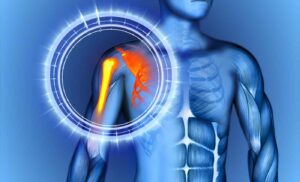Shoulder pain is a common complaint among women that can greatly impact their daily lives. The intricate structure of the shoulder joint, coupled with various lifestyle and physiological factors, contributes to this discomfort. Understanding the underlying causes, prevention methods, and available treatments is crucial for addressing and managing shoulder pain effectively. In this blog, we will delve into the various causes, symptoms, and treatment options for shoulder pain specifically in women.
Contents
Understanding Shoulder Anatomy

The shoulder is a complex and highly mobile joint that allows a wide range of movements. It consists of several bones, muscles, ligaments, and tendons that work together to provide stability and mobility. Let’s delve into the key components of shoulder anatomy:
- Bones:
- Clavicle (Collarbone): The clavicle is a long bone that connects the sternum (breastbone) to the scapula (shoulder blade).
- Scapula (Shoulder Blade): The scapula is a flat, triangular bone located on the back side of the shoulder. It plays a vital role in connecting the arm to the trunk of the body.
- Humerus: The humerus is the upper arm bone that forms the main connection between the shoulder and the elbow. Its head fits into the glenoid cavity of the scapula to create the shoulder joint.
- Joints:
- Glenohumeral Joint: This is the main joint of the shoulder, formed by the head of the humerus fitting into the shallow glenoid cavity of the scapula. It is a ball-and-socket joint that allows a wide range of motion.
- Acromioclavicular (AC) Joint: This joint connects the acromion of the scapula to the clavicle. It is responsible for movements of the scapula, especially during arm movements above shoulder level.
Common Causes of Shoulder Pain in Women
Overuse and repetitive strain are leading causes of shoulder pain. Some of the other causes are:
- Rotator Cuff Injuries: The rotator cuff is a group of muscles and tendons that stabilize the shoulder joint. Overuse, trauma, or wear and tear can lead to strains or tears in these structures, causing pain and a limited range of motion.
- Frozen Shoulder (Adhesive Capsulitis): This condition involves the inflammation and tightening of the shoulder joint capsule, leading to stiffness and pain. Hormonal changes, especially during menopause, can make women more susceptible to frozen shoulders.
- Tendonitis and Bursitis: Inflammation of the tendons (tendonitis) and bursae (bursitis) around the shoulder joint can result from repetitive movements, lifting heavy objects, or poor posture.
- Posture-Related Issues: Modern lifestyles often involve prolonged sitting and extensive use of electronic devices, contributing to poor posture. This can strain the muscles of the shoulder and neck, causing pain.
- Hormonal Factors: Fluctuations in hormone levels during menstrual cycles, pregnancy, and menopause can impact joint laxity and pain sensitivity, potentially exacerbating shoulder discomfort.
- Osteoarthritis and Rheumatoid Arthritis: These degenerative and autoimmune conditions respectively can affect the shoulder joint, causing pain, inflammation, and reduced mobility.
Hormonal Factors and Shoulder Pain

Hormonal factors can play a role in the experience of shoulder pain, particularly in women. Hormones are chemical messengers that regulate various bodily functions, including pain perception, inflammation, and joint stability. Fluctuations in hormone levels can impact joint health and pain sensitivity. Here’s how hormonal factors can contribute to shoulder pain:
1. Menstrual Cycle: During the menstrual cycle, women experience fluctuations in estrogen and progesterone levels. These hormonal changes can affect pain perception and joint laxity.
- Estrogen: Estrogen has anti-inflammatory properties and can influence pain perception. Around the time of ovulation, when estrogen levels peak, some women might experience joint and muscle discomfort, including in the shoulders.
2. Pregnancy: Pregnancy involves significant hormonal changes that can affect various parts of the body, including the shoulders.
- Relaxin: During pregnancy, the hormone relaxin is produced to soften ligaments and prepare the body for childbirth. This increased joint laxity can lead to altered shoulder biomechanics and potentially contribute to pain.
3. Menopause: Menopause marks a significant hormonal transition for women, as estrogen and progesterone levels decline. These changes can impact joint health and pain perception.
- Reduced Estrogen: The decrease in estrogen levels during menopause may lead to reduced collagen production, which can affect the strength and integrity of joint structures, including those in the shoulders.
Lifestyle Factors and Shoulder Pain
Lifestyle factors can significantly influence the development and management of shoulder pain. Our daily habits, activities, and choices can impact the health of our muscles, joints, and overall well-being. Here’s how lifestyle factors can contribute to shoulder pain:
1. Poor Posture:
- Spending long hours sitting at a desk, working on a computer, or using mobile devices can lead to poor posture.
- Slouching or hunching over can strain the muscles and ligaments around the shoulders and neck, leading to discomfort and pain.
2. Sedentary Lifestyle:
- Lack of regular physical activity and exercise can weaken the muscles that support the shoulders.
- Weak muscles may not provide adequate support, leading to instability and an increased risk of injuries.
3. Overexertion and Repetitive Movements:
- Engaging in activities that involve repetitive shoulder movements or lifting heavy objects can strain the muscles and tendons around the shoulder joint.
- Overexertion without proper warm-up and stretching can lead to muscle fatigue and pain.
4. Incorrect Lifting Techniques:
- Lifting heavy objects using improper techniques, such as using the shoulders instead of the legs, can put excessive strain on the shoulder muscles and joints.
5. Lack of Stretching and Flexibility:
- Neglecting to stretch and maintain flexibility can lead to muscle imbalances and reduced range of motion in the shoulders.
- Stiff muscles are more susceptible to injuries and discomfort.
Pregnancy and Shoulder Pain

Pregnancy is a transformative period in a woman’s life, marked by numerous physiological changes that can contribute to various discomforts, including shoulder pain.
While shoulder pain during pregnancy is relatively less common than other pregnancy-related symptoms, it can still occur due to several factors. Here’s how pregnancy can be linked to shoulder pain and what you can do about it:
- Hormonal Changes: During pregnancy, hormonal fluctuations occur to support the growth and development of the fetus. One hormone in particular, relaxin, is produced to relax the ligaments in the body, including those around the joints. This increased joint laxity can sometimes affect the shoulders and contribute to discomfort.
- Postural Changes: As the baby grows, the body’s center of gravity shifts forward, prompting changes in posture to maintain balance. This shift can lead to changes in shoulder alignment and muscle tension, potentially causing shoulder discomfort.
- Sleeping Positions: As pregnancy progresses, finding a comfortable sleeping position becomes challenging. Many pregnant women prefer sleeping on their sides, which can sometimes lead to shoulder pain if one side is favored more than the other.
- Carrying Additional Weight: The added weight of the growing baby and changes in body shape can lead to changes in biomechanics, potentially causing muscle strain and discomfort in various areas, including the shoulders.
Medical Conditions and Shoulder Pain
Shoulder pain can be caused or exacerbated by various medical conditions. These conditions can affect the structures within or around the shoulder joint, leading to discomfort, limited mobility, and reduced quality of life. It’s important to note that proper diagnosis by a healthcare professional is essential for accurately identifying the underlying medical condition and determining the appropriate treatment. Here are some medical conditions that can contribute to shoulder pain:
Rotator Cuff Injuries:
- Rotator cuff injuries involve damage to the muscles and tendons that stabilize the shoulder joint.
- Conditions like rotator cuff tendinitis or rotator cuff tears can cause pain, weakness, and limited range of motion.
Frozen Shoulder (Adhesive Capsulitis):
- A frozen shoulder is characterized by the inflammation and tightening of the shoulder joint capsule.
- It leads to significant stiffness, reduced range of motion, and shoulder pain.
Bursitis:
- Bursitis involves inflammation of the bursae, small fluid-filled sacs that cushion and reduce friction between bones, tendons, and muscles.
- Bursitis in the shoulder can cause localized pain and tenderness.
Osteoarthritis:
- Osteoarthritis is a degenerative joint disease that leads to the breakdown of cartilage.
- Shoulder osteoarthritis can cause pain, stiffness, and reduced mobility in the joint.
Rheumatoid Arthritis:
- Rheumatoid arthritis is an autoimmune disease that affects the joints, including the shoulder.
- It leads to joint inflammation, pain, and potential joint deformities.
Mental Health and Shoulder Pain
Mental health and physical well-being are interconnected in complex ways, and this connection can extend to conditions like shoulder pain.
Stress, anxiety, depression, and other mental health factors can influence how we perceive and experience physical pain, including pain in the shoulders. Here’s how mental health and shoulder pain can be intertwined:
- Stress and Tension: Stress, whether acute or chronic, can cause muscle tension and tightness in various parts of the body, including the shoulders. Tense muscles can lead to discomfort, pain, and restricted movement.
- Muscle Tension: Stress and anxiety can lead to involuntary muscle contractions, contributing to muscle tension in the neck, shoulders, and upper back.
- Pain Perception: Mental health conditions can alter how the brain processes pain signals. Increased stress and anxiety levels may heighten pain sensitivity, causing even mild discomfort to feel more intense.
- Altered Body Awareness: Anxiety or depression can lead to heightened body awareness and self-focus. This increased attention to bodily sensations may magnify the perception of pain.
Conclusion
Shoulder pain in women is a multifaceted issue influenced by anatomy, lifestyle, and hormonal factors. By understanding the causes, taking preventive measures, seeking medical help when necessary, and adopting holistic self-care practices, women can alleviate and manage shoulder pain to lead a more comfortable and active life.
If you’re experiencing Shoulder pain, physical therapy for shoulder pain at PhysioMantra can help: Book an online physical therapy session.



